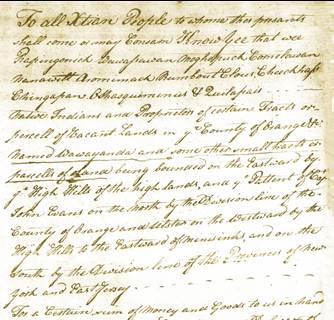Colonial Government;
Cultural Differences
Primary Document: Indian Deed of March 5,
1702-03

Opening lines of the Indian Deed for the Wawayanda
Patent.
Much of the Town of Warwick was conveyed by this deed; the portion later claimed and settled by Benjamin Aske was the valley around Rt. 94 south of the Village of Warwick
The “mark” or signature of Chuckhass, the Native American chief at the village of Mistucky, south of Warwick village.
We are not sure that the Native Americans understood the impact of what they were signing, and some scholars think the deed was a fraud.
It’s difficult to read the old script,
isn’t it? But if you
compare with the letter “u” in the rest of the document, it looks like this name
should have been
read as “Cheeckhass”, not Chuckhass, which was carried forward to today.
Another copy of this document shows it more like “Chuckhass”. Translating the
native language
phonetically to English was a challenge, and often distorted the pronunciation. We will never really know what his name sounded like, but our words are probably pretty close.